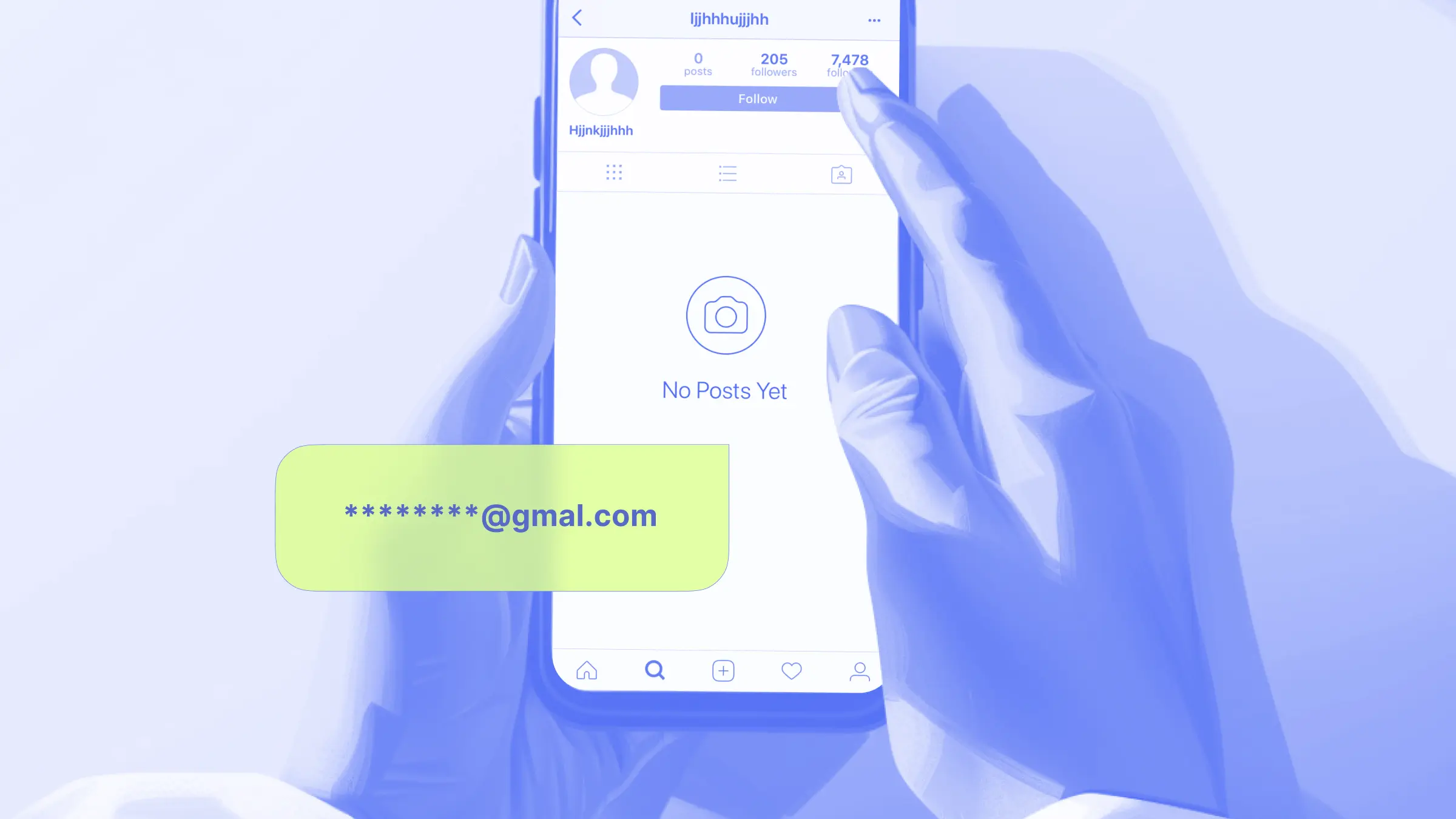

In case one suspects that you were approached by a fake on Instagram, the user might want to expose their true identity. Seeking an email used by a fake account is often the best option, as the same address might be utilized for other social media and services that lead to the real name of the culprit.
However, it can be tedious to investigate the email all by yourself without any previous OSINT experience. Read through this comprehensive X-Ray Contact guide to learn all the ins and outs of finding and disclosing an email behind a fake Instagram account. That’s the way to learn how to find who owns an Instagram account.
What Is a Fake Instagram Account?
A fake Instagram account is a profile created on a social media platform that does not accurately represent the identity of the person behind it. Such accounts often have made up personal details like name, location, demographic data and take photos of other real people as their profile pictures. Nonetheless, bare in mind that some fake Instagram account owners are transparent that they use someone else’s or made up information when others are not. The approach differs depending whether the user intends to use an Instagram account to deceive others.
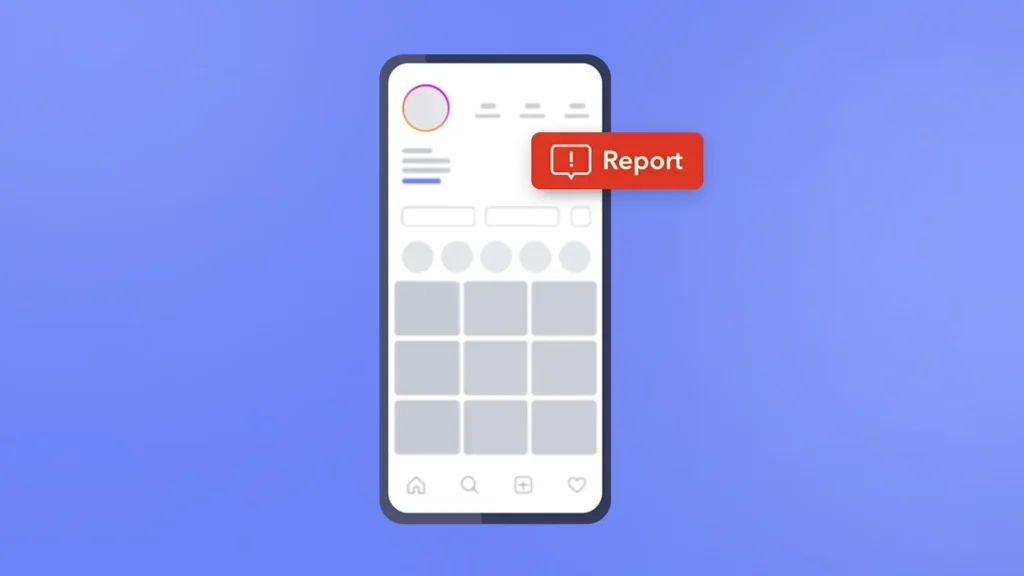
Signs That an Instagram Account Is Fake
There are obvious red flags that hint at a fake Instagram account. Remember that these features of an Internet profile are suspicious:
- Lack of Data. Untrustworthy profiles often have incomplete or sparse profile information. It can include missing profile pictures, a lack of bio description or minimal posts.
- Account Has Been Created Recently. Be suspicious of new users as they are frequently set up for short-term purposes such as spamming or scamming. You can check the Instagram account’s creation date by tapping on three dots in the right screen corner and navigating the “About This Account” section. Look for the “Date Joined” option to find this information.
- A Suspicious Username. Fake accounts may have random strings of characters or numbers in their usernames, or they may use a variation of a popular name or brand to appear legitimate. In contrast to culprits, innocent users tend to have more thought-through and unique usernames in their digital footprint.
- Low Follower Count. Suspicious Instagram profiles typically have a significantly lower number of followers compared to genuine accounts. However, this isn’t always the case, as some fake accounts may use bots to artificially inflate their follower count.
- A Large Number of Followed Accounts. Scam profiles often mass spam users on Instagram. That’s why they often follow a large number of other accounts but have relatively few followers themselves.
- Generic Content. Fake accounts may use profile pictures or images stolen from the Internet. The Reverse Image Search tool from X-Ray Contact can help you determine whether a profile picture is unique or stolen.
- Overuse of Hashtags. Scam accounts often overuse hashtags in an attempt to attract attention and get more engagement. Look out for profiles that include a long list of hashtags in their posts, especially if they are unrelated to the content.
- Low or Zero Engagement. Such Instagram accounts almost always have low engagement rates, with few likes, comments or shares on their posts. This happens because they often have inactive or bot followers who don’t interact with the content.
- No Outside Information. Legitimate businesses and public figures often provide contact information in their Instagram bio, such as a website link or email address. However, fake accounts may lack these details and are not mentioned on any other website.
- Strange Direct Message Requests. If you receive unsolicited messages from accounts you don’t know, it could be a sign of a fake account or a scam. Be cautious and avoid clicking on any links or providing personal information to them just to stay safe.
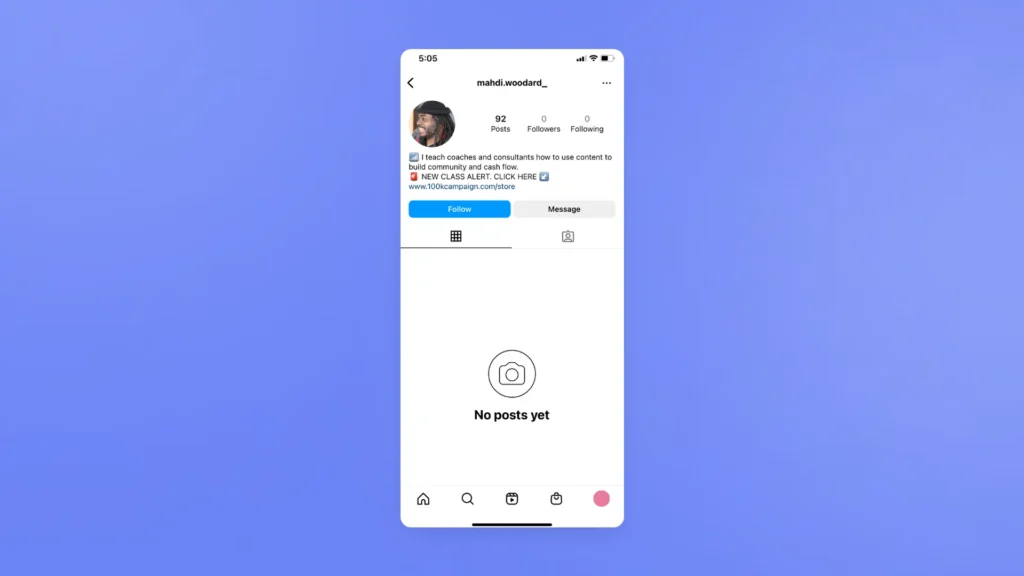
Why Might People Create a Fake?
While some fake accounts are created innocently for personal reasons, others may be used for nefarious activities. Let’s recap the main purposes of a fake Instagram, which can be both harmless and harmful:
- Stay Anonymous Online. A popular reason for using a fake Instagram account is to maintain privacy and to interact with content or individuals without revealing one’s true identity.
- Scam the Users. Digital fraudsters may create fake Instagram accounts to take advantage of other people. They might pretend to be a credible entity or create a persona to gain the trust of others and then manipulate them into providing personal information or money.
- Market the Products or Services. Some businesses or individuals tend to create fake Instagram accounts to boost their online presence or promote their offerings. The practice can be used to artificially inflate follower counts or engagement metrics. However, utilizing fake profiles for marketing can be dangerous as well if scamming businesses use bots to seem more credible in the eyes of potential victims.
- Impersonate Other People. The suspicious profiles might be created to impersonate someone else, either as a prank to deceive others or to engage in malicious activities such as defamation or harassment.
- Gather Intelligence. For OSINT specialists or private investigators, a fake social media profile can be a means of data collection. This process can involve creating fake personas to infiltrate groups and get information about individuals or organizations. For example, a SOCMINT pro might need to earn the trust of a target and get into a Close Friends list on Instagram. Then, a researcher can analyze more authentic and exclusive content posted by the person of interest.
- Organize a Romance Scam. Catfishing is the practice of creating a fake identity to deceive someone into forming a romantic relationship online. This process is ethically wrong as it can lead to negative psychological consequences for the victim.
- Cyberbully Innocent Users. Unfortunately, some culprits use fake Instagram accounts to troll, blackmail or otherwise harass their targets. Such people take advantage of the ability to stay anonymous online as well as have access to their victims via direct messages.
How to Know If an Instagram Account Is Fake

Even though some fake Instagram accounts can be very convincing, there are ways to verify whether the profile is genuine or not. You can do the following:
- Check Out the Username and Content. Authentic accounts usually have usernames and handles that are coherent and relevant to the account’s content or the user’s identity. Moreover, fake accounts may use obvious stock photos or images sourced from the Internet as profile pictures. Be aware of the profiles with low-quality images, repetitive posts or nonsensical photo captions.
- Analyze the Interactions. Fake accounts may follow a large number of users but have minimal interaction with them. They may also leave generic or spammy comments on posts.
- Pay Attention to the Verification Badge. Profiles with a blue verification badge next to their username are verified by Instagram as authentic. Therefore, if you receive a message from a famous person’s account that does not have a verification sign, good chance you’ve been contacted by the scammer.
- Look for Similar Accounts. If you suspect a profile is fake, search for similar accounts using the same profile picture or username. In case you find multiple accounts with identical or similar content, it can be a network of bots or a case of identity theft.

How to Find Who Is Behind a Fake Instagram Account
If you have evidence and a strong gut feeling that the account is not real, you can make an effort to disclose the true identity of the person behind the profile. Let’s analyze the approaches you might choose in order to expose a fake account and even possibly bring it to justice.
1. Conduct a Reverse Image Search with X-Ray Contact
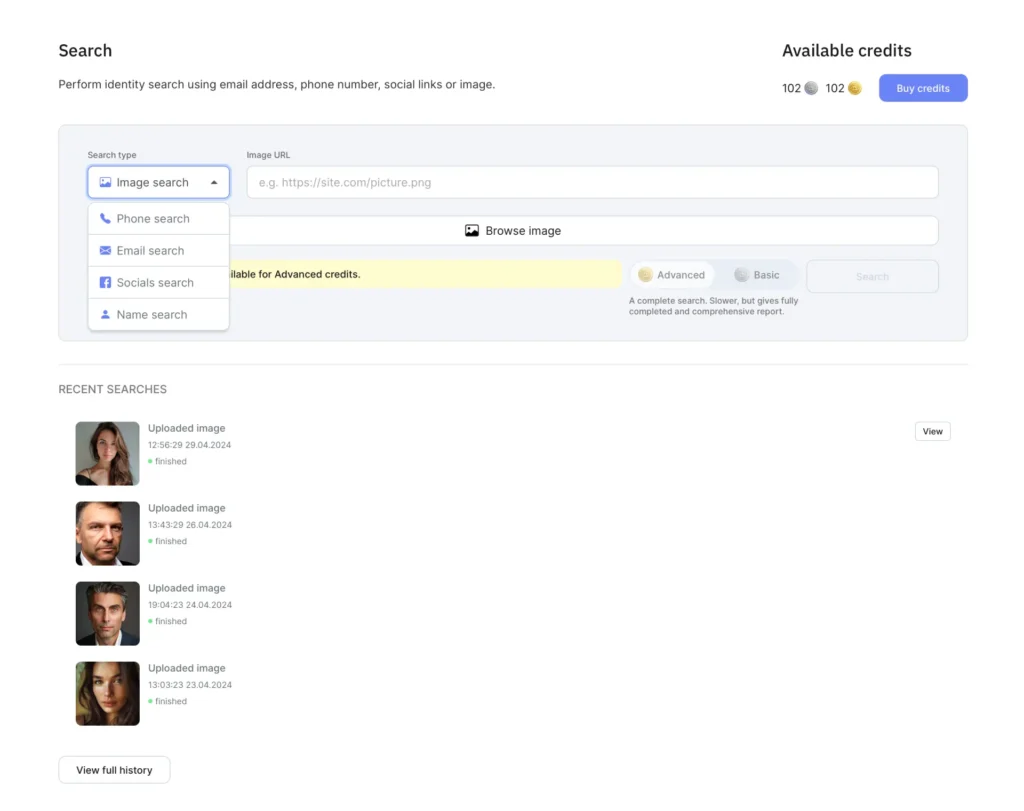
If the account is using stolen or stock photos as a profile picture or in its posts, conduct a reverse image search using the X-Ray Contact service. This can help identify if the images have been used elsewhere online and potentially lead to the original source or owner. The investigation algorithm is simple even for the OSINT amateurs:
- Tap on the “Platform” option in the site’s header and select “Image” as an investigation channel.
- Now, you can either type in a URL or upload the image from your device.
- Our face recognition technology will go through the picture databases of the providers in order to spot the similarities. In case there is a match, the system will form a report with all data it is possible to find on a user with the open source intelligence. It may include a real name, email address, examples of other photos, demographic data and more.
2. Use an App That Detects Fake Instagram Accounts
You may wonder, what is the app that detects fake Instagram accounts? There is no single tool that would be able to identify the scammer profile. However, you can adapt some general-use tools to analyze suspicious accounts. Such instruments like Inflact Profile Analyzer can help you collect statistics about profile activity. Use this info to study who is in the network of the account and arrive at a conclusion as to whether it is a legitimate, real human profile.
3. Try WHOIS Tool
Use this instrument for phishing detection. Many fake Instagram accounts are part of scams that redirect users to phishing websites. By looking up the linked domain you can assess the legitimacy of the account and even avoid security risks. You can use Whois.com to check the domain’s registration details in order to compare the words of a person with their real domain history.
4. Reverse Image Search With TinEye
You can reveal whether a person uses someone else’s pictures with the help of TinEye. Many fake accounts use profile pictures or posts stolen from real people or stock photos. If TinEye reveals that the photo was posted before by a different author, it’s a red flag for a fake account.
5. Find Out the Email of a Fake Instagram Account
If the reverse image search is unsuccessful or useless, another solution is to focus your attention on getting the real email address of the user with email lookup tools. There might be a few strategies you need to combine in order to expose a real email address used to register the account as well as find leads to the real personal details and other digital footprint of the user. Here’s what you can do to find out the email of a fake Instagram account:
Use X-Ray Contact
X-Ray Contact is a convenient data aggregation tool that can work with as little information as just a link to a social media profile. Follow these steps to learn how to find out the email address using only an Instagram profile URL.
- Go to the “Platform” section and select “Social” as an available search channel.
- Insert a link to the fake Instagram account and wait as the system processes it.
- If the profile has previously been featured in the databases of our providers, you will receive a report with all details available about the user, including the email address.
Do a Sign-In Check
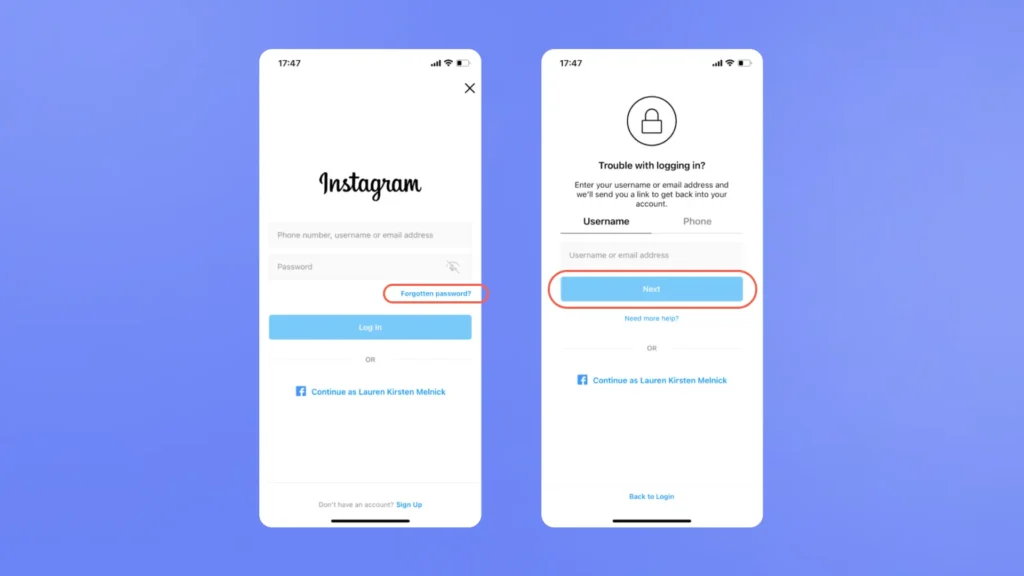
This method might make your target know that someone is trying to expose their email. However, it can lead you to quick and easy results.
- Choose the “Add Account” option on Instagram and type in the username of the suspected fake.
- Then, choose the “Forgotten Password” feature and repeat the username, so that the person will receive a confirmation message.
- At this stage, you will see either an email address or the phone number of the user. However, be cautious as your investigation might become obvious to the target due to this method.
Contact the Support
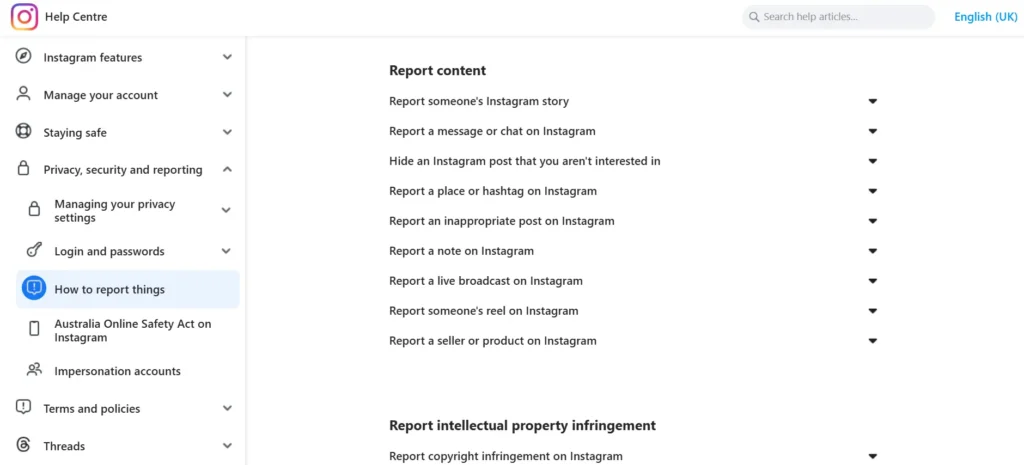
In the situation when the owner of the fake account has covered their tracks, and you can’t find their email address with OSINT, you can request help from Instagram. If you have a legitimate reason for needing to access the email address associated with a fake account, you can try reaching out to Instagram support. Explain your situation and provide any evidence you have regarding the user. Even if Instagram may not directly provide you with the email address, they may take action against the account if the profile violates their policies.
Pay Attention to Email Red Flags
Better be safe than sorry when it comes to email Instagram scams. You can prevent unfortunate situations not only with email lookup tools, but also by paying attention to general red flags in email domains:
- Wrong spelling of the email domains. For example, instead of “@instagram.com,” you might see “@insta-gram-support.com.”
- The display name might show “Instagram Support,” but the actual email could be from a suspicious domain.
- Real emails from Instagram have consistent branding and layout that stays the same throughout.
- Moreover, don’t click on links or download files if you weren’t expecting an email. Pay attention to awkward phrasing, typos, and urgent claims as they are common for scammers.
Ethics of Email Lookup
Nonetheless, the main rule of your investigation should be the focus on respecting the privacy of the target. There is a threshold between non-intrusive open source intelligence gathering we’ve discussed and intrusive hacking. That’s why we recommend avoiding platforms or methods that bypass privacy settings or exploit vulnerabilities to hijack the Instagram account. Moreover, you should avoid breaking the law in any way and violating the privacy of the person as it may lead to legal repercussions.
Conclusion
A link to a fake Instagram account can be a sufficient starting point of unveiling a scammer online. The most effective approach is to focus on getting hands on an email address and then utilize it to branch out the investigation and find more clues about the user. That’s how you can expose a culprit and protect other innocent users from becoming the victims.


